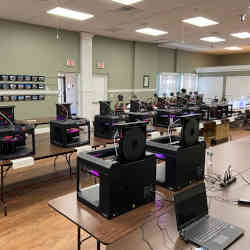
The COVID-19 pandemic has created enormous challenges for medical professionals, but no problem has been more glaring than the lack of personal protective equipment (PPE) and medical gear. Face shields, N-95 masks, test kits, and other items have been difficult, if not impossible, to find. Ventilator shortages have raised the stakes for sick patients.
Amid the chaos and problems, one thing became clear: obtaining all the needed equipment and supplies through conventional channels was next to impossible. As a result, hospitals and healthcare workers have taken things into their own hands. Many have turned to three-dimensional (3D) printing to produce essential items, often tapping online communities and open source printing scripts.
"The pandemic has opened people's eyes to the incredible utility of 3D printing," said Albert Chi, an associate professor of surgery and trauma surgeon at Oregon Health & Science University (OHSU).
Added Xavier Martínez Faneca, CEO of 3D printer manufacturer BCN3D, based in Barcelona, Spain, "3D printing offers two major advantages. It's the fastest way to produce items, and it promotes decentralized manufacturing."
Devices on Demand
Also known as additive manufacturing and rapid prototyping, 3D printing has clearly gained traction in recent years. Online data analysis firm Statistica projects 37% of firms in the U.S. will use the technology by next year, up from only 4% in 2016. Within medicine, 3D printing is now widely used to produce prostheses, dental implants, medical tools, and more from nylon, plastics, metals, and other materials.
The novel coronavirus pandemic has ignited 3D printing. Around the world, 3D printing has allowed medical providers to act quickly amid massive shortages of essential items and equipment. For example, at Beth Israel Deaconess Medical Center in Boston, MA, specialists have tapped materials normally used in dental implants to produce nasopharyngeal swabs for test kits. Working within an industry consortium, and after perfecting a design within 22 days, the group began printing 200,000 swabs daily, with an eye toward producing more than a million a day soon afterward.
In Spain and France, a network of medical experts and volunteers, working with BCN3D, used open source scripts to print more than 4,200 face shields. The 3D-fabricated protective gear was distributed among more than 70 hospitals and health centers. Each printing system can produce about 180 shields in four hours, Faneca says.
Meanwhile, a team at the University of Buffalo In New York State has developed a 3D-printed prototype for a reusable N-95 respirator (protective mask), which must meet stringent quality standards. The open source design—which is made from hard plastic and customized for different facial features in order to produce a better fit—includes an opening to insert a MERV 15 air filter, which is widely used in hospitals. The device can be sanitized after each use.
Breathing Easier
A widespread, acute shortage of ventilators also has created enormous problems for hospitals and patients. With conventional hospital-grade ventilators costing between $25,000 and $50,000 and largely unavailable, medical experts have also directed their attention to printing equipment that can typically cost anywhere from a few hundred dollars to a few thousand dollars.
"3D printing dramatically reduces the cost of producing a device but, more importantly, it allows medical professionals to react quickly to changing needs," said Aurika Savickaitė, a nurse practitioner, formerly at University of Chicago Medical Center, who heads an initiative, HelmetBasedVentilation.com, that produces 3D-printed parts for FDA-approved "bubble helmets" that provide noninvasive oxygen delivery for COVID-19 patients.
Another more-sophisticated ventilator has been developed by OHSU's Chi, who has previously used 3D printing to produce prosthetic devices and myoelectric exoskeletons for patients with upper extremity dysfunction. Chi, working with a multidisciplinary team of experts, including OHSU research engineers Evan Fontaine and Whitney Menzel, developed a design that allows a hospital or clinic to print all needed ventilator components within three to eight hours, at a cost of about $10 in materials. The group collaborated with industry partners NIKE, 3D Systems, and Stratasys to validate the design, which functions without electricity.
"3D printing represents the ultimate rapid design method," Chi said, adding, "there is a large community to provide input and evaluation of a design." It took the group about four weeks to develop the ventilator, which uses materials that can be autoclaved for sterilization. He plans eventually to share the ventilator design through an open source framework, and to gain FDA approval for it.
Chi believes the pandemic has demonstrated the value of 3D printing and its power to address the limitations of conventional manufacturing processes through rapid design prototyping and manufacturing. "We are seeing creative and functional designs emerge as people recognize the potential role of this technology in the medical community."
Samuel Greengard is an author and journalist based in West Linn, OR, USA.



Join the Discussion (0)
Become a Member or Sign In to Post a Comment